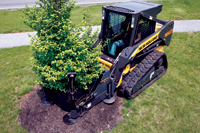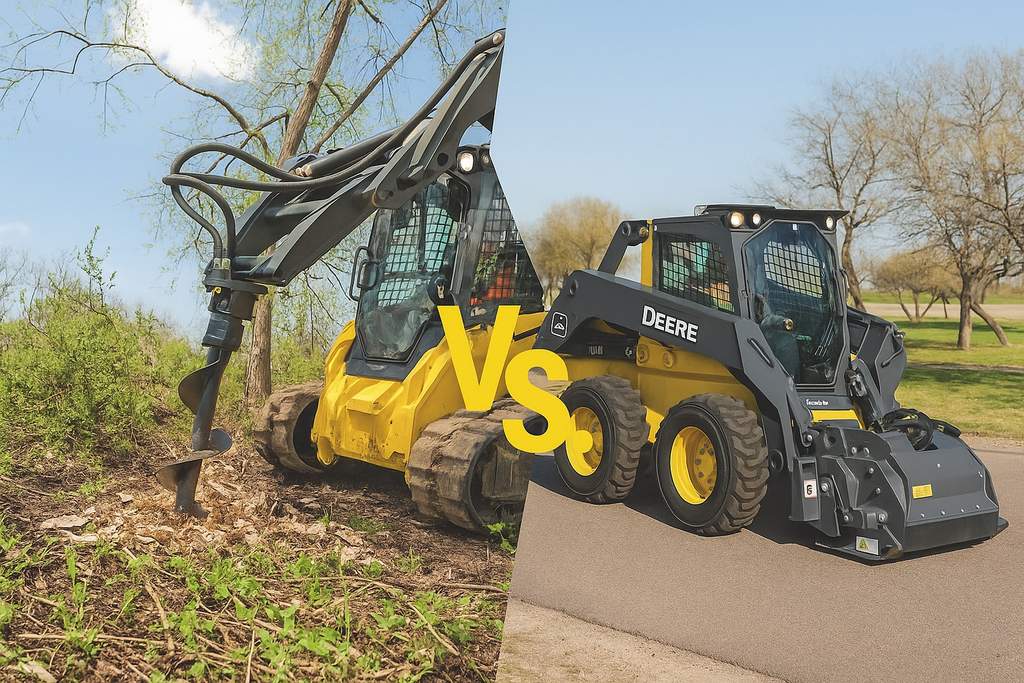Ace Your Spades

Trees outshine most people in the extent and depth of their work for the public good. An essential part of natural and planned landscaping, trees not only serve to beautify green space, but they disperse rainfall and reduce topsoil run off. They take years to grow, so it’s important to have the right tools when it comes time to planting and transplanting.
With a variety of tree spade attachments on the market for skid steers, how do you find the one that’s right for your needs and your tool carrier? Whether for a professional landscaper or a budding entrepreneur, everyone can use a few good tips on tree spades for skid steers. Let’s start at the beginning with how a tree spade attachment works.
 Say goodbye to the old days of manual labor. The 21st century is about convenience. Tree spades have hydraulic powered shovels that surround the tree to cut both the soil and roots around the tree trunk. And, as with most conveniences, there is a price tag attached. Tree spade attachments range from less than $5,000 for a small, compact spade to over $15,000 for large models.
Say goodbye to the old days of manual labor. The 21st century is about convenience. Tree spades have hydraulic powered shovels that surround the tree to cut both the soil and roots around the tree trunk. And, as with most conveniences, there is a price tag attached. Tree spade attachments range from less than $5,000 for a small, compact spade to over $15,000 for large models.
Tree spades are heavy attachments and require more operating capacity from your skid steer loader or compact track loader. You’ll need an operating capacity between 1,650 and 2,800 lbs. You also want to ensure your machine has good visibility. Dave December, marketing manager for skid steer loaders at New Holland Construction, recommends a see-through cab roof which allows for a clear view of the tree, even when the spade is positioned at full height.
To decide what size tree spade is needed you will need to first determine the diameter, or caliper, of the tree at 1 ft above the ground. As a rule of thumb, you’ll want 10 in. of soil diameter for every 1-in. diameter of tree trunk. So a 3-in. diameter tree would have a 30-in. root ball.
There are three basic types of tree spades to choose from:
1. Cone shaped spades allow the blades to close completely to cut all of the roots.
2. Truncated spades have more vertical blade angle to give a more pot-shaped root ball. This maximizes the amount of root structure and also provides a flat bottom for the tree to stand until transplanted.
3. Undercutting spades cut under the ball to cut all the roots and help to support the root ball when lifting. This spade is ideal for clay-type soils and looser sandy soil.
Truncated and undercutting spades are generally preferred over cone shaped spades because they keep the most roots with the tree. The more roots that stay with the tree, the greater the opportunity to reduce plant mortality.
Standard tree spade attachments for skid steers and compact track loaders will give you a ball diameter of between 18 and 44 in. When selecting the right tree spade attachment for your machine, the main thing to consider is your machine’s lift capacity or operating load. Keep in mind you’re lifting not only the weight of the tree spade itself, but also the weight of the tree and ball of dirt. Smaller machines, up to 1,650 to 1,800 lbs of lift capacity, can generally be equipped with up to a 24-in. ball diameter tree spade.
Larger machines, with lift capacities between 2,200 to 2,800 lbs, can handle the larger model spades, up to 44 in. Cone shaped blades with a shallow blade angle create less ball than truncated or undercutting models, which generally have a steeper angle.

When operating a tree spade, be sure to protect the tree branches. Center the spade to the tree trunk and be sure to handle with care. Typically, the attachment can be operated from inside the machine, fully operated from the loader’s control handles with an integrated multi-function handle kit. But remember safety first! Always remember to call before you dig to locate underground utilities. Keep bystanders away from machine pinch points and sharp blades.
To care for your tree spade, be sure to grease metal sliding surfaces and pivots per manufacturer recommendations. Keep blades sharp to reduce root damage. When storing, coat blades with a rust inhibitor and protect all electrical components.
Other popular tree-oriented attachments include: plant handlers, to carry and load burlapped trees safely; earth augers, to dig holes for transplanting; and fixed blade tree shovels for digging holes and transporting balled trees. Nursery forks and tree-tying attachments can also come in handy.
Holly Fowler is the North American marketing manager for New Holland Construction, based in Carol Stream, Ill.
Shear Clipping ActionOne of the more expensive tree-tool attachments, tree shears are used to trim or remove both hard and soft trees and branches. Ranging from $4,750 to $12,500, tree shears come in two different models — standard and high-reach. Built with two large cylinders and knife-like jaws, standard shears are designed to remove a tree by clipping it at the base of its trunk. Some shears come equipped with an accumulator, which is an arm that holds the tree up after it has been clipped. When using an accumulator, loader operators must always proceed with caution, ensuring that the skid steer has enough capacity to handle the tree being removed. High-reach clippers are generally used for trimming tree-branch overgrowth. The attachment has a long reach and a rotating shear head that clips branches growing in many different directions. Stumps & GrindersTree removal is a two-step process: first the tree, then the stump. Stump grinders, which cost between $5,000 and $6,000, are used to remove the remaining stumps in an area that has been cleared of trees. A spinning stump-grinder head has carbide-tipped teeth that chip at tree stumps until they are deep enough in the ground to allow grass to grow or a surface to be laid. The attachment swings hydraulically, so the operator can make two passes; each pass is 1 to 2 in. deep. |





Comments are closed here.